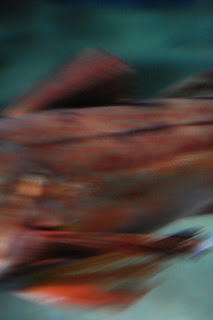So after however
many weeks of doing this project, I finally feel as though I’ve found the
missing piece. It happened while I was at the lion enclosure photographing the
cubs. There were no people around; the rain must have driven them to the
reptile house or other sheltered enclosures, so I had the lions all to myself.
Then a man joined me, he opened his bag and produced an old battered looking
diary. Intrigued, I struck up conversation, very poorly I must admit - commenting
on the weather or something trivial like that. But it worked, and we were soon
talking about his knowledge of the animals and times spent at London Zoo. I spent half my day talking and walking around the zoo with him, and I can honestly say it was one of the
most insightful and powerful conversations I have ever had…
Transcription of our conversation:
“Were you here when the Polar Bears were here? Didn’t they pace up and down?”
- “ Oh yes, Brumas I got a photograph of in
the 50s, of Brumas, when he was born, he was the first polar bear to be born in
captivity. Over their at Bear Mountain, that's where the bears where, but
they’re now at Whipsnade, they know me very well because I've known them since
they were born, I go down there and they acknowledged me. Sometimes makes your
day worthwhile when you’re acknowledged by the animals.”
“So how many years have you been coming
here?”
- “When I first started coming to London Zoo? 1938… Since I’ve been retirement I’ve been coming four times a week for four years.”
- “I Select certain animals that I bond with
and I see those; I don’t try and do the whole zoo. People come and try and get
round the zoo as quickly as possible, I think if you find something you particularly
like and spend half a day with that particular exhibit then you’ll take
something way.”
“So what animals have you chosen?”
- “The red faced spider monkeys – I mean
Paulette has been here since 1980 and she never fails to give me a greeting! She’s
getting very old now but when you call her she comes over…Her best friend is the
vet, if she ever needed any treatment she always knew if the vet was on the
premises, if she needed any (treatment) she just hold out her arm for an injection, I mean she's adorable.
I do like the lamas as well; the gorillas are way up the top really.”
“So did you work
for the zoo?”
- “No no, but I’ve
always been interested, I started coming because I got friendly with the Ravens…”
- “I just love animals,
once they give there love, I mean a top male gorilla keeper here told me the
biggest rule in life with a gorilla is that you can’t give your love to them,
they have to give their love to you, and once they do he says it’s the best
experience you’ll have in life…better than anything if a gorilla gives its love
to you!”
- “But if you do
something to upset it then that’s it, you loose their trust!”
- “But they’re very
intelligent…gorillas are the most gentle creatures on the planet really, but
with all the King Kong films they just make then into these, you know…”
His knowledge and
devotion towards the individual animals was mesmerizing. He spoke of them as if
they were people, with human feelings. The animals are such a key part in his
life, he showed me his diary where he keeps note of the animals he’s most
interested in. The pages were covered in crossings out, scribbled note, dates
and facts about his chosen animals. He knows all their names, dates they were
born, what they were fed, everything! But the most shocking and incredible part
was that they know him! As we walked around he spoke to the animals, asking how
they are, beckoning them over, and they came! They recognized his voice came
over to us. He was like a living Doctor Doolittle! The whole experience
completely blew me away! I feel so privileged to have met him and heard all his
wonderful, influential tales about his experiences with animals. His views have
made such a powerful impact on me; I don’t think I’ll ever forget our walk that
day. He has devoted his life to animals and seems to love them like family,
this has made me believe a bond between mankind and the animal kingdom is essential
and worth fighting for.










































